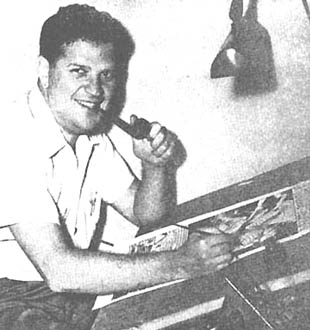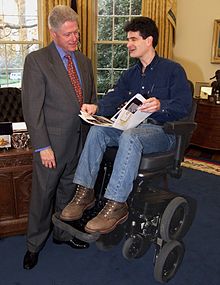
Assistive technology (AT) is a term for assistive, adaptive, and rehabilitative devices for people with disabilities and the elderly. Disabled people often have difficulty performing activities of daily living (ADLs) independently, or even with assistance. ADLs are self-care activities that include toileting, mobility (ambulation), eating, bathing, dressing, grooming, and personal device care. Assistive technology can ameliorate the effects of disabilities that limit the ability to perform ADLs. Assistive technology promotes greater independence by enabling people to perform tasks they were formerly unable to accomplish, or had great difficulty accomplishing, by providing enhancements to, or changing methods of interacting with, the technology needed to accomplish such tasks. For example, wheelchairs provide independent mobility for those who cannot walk, while assistive eating devices can enable people who cannot feed themselves to do so. Due to assistive technology, disabled people have an opportunity of a more positive and easygoing lifestyle, with an increase in "social participation", "security and control", and a greater chance to "reduce institutional costs without significantly increasing household expenses." In schools, assistive technology can be critical in allowing students with disabilities to access the general education curriculum. Students who experience challenges writing or keyboarding, for example, can use voice recognition software instead. Assistive technologies assist people who are recovering from strokes and people who have sustained injuries that affect their daily tasks.

Dean Lawrence Kamen is an American engineer, inventor, and businessman. He is known for his invention of the Segway and iBOT, as well as founding the non-profit organization FIRST with Woodie Flowers. Kamen holds over 1,000 patents.

A Segway is a two-wheeled, self-balancing personal transporter device invented by Dean Kamen. It is a registered trademark of Segway Inc. It was brought to market in 2001 as the Segway HT, and then subsequently as the Segway PT.HT is an initialism for "human transporter" and PT for "personal transporter."
A vibrating structure gyroscope, defined by the IEEE as a Coriolis vibratory gyroscope (CVG), is a gyroscope that uses a vibrating structure to determine the rate of rotation. A vibrating structure gyroscope functions much like the halteres of flies.

DEKA Research & Development Corporation is a technology company based in New Hampshire, U.S., founded in 1982 by Dean Kamen, consisting of nearly 400 engineers, technicians, and support staff. DEKA is an acronym derived from Dean Kamen. The company is located in a series of old Amoskeag Falls Millyard buildings in Manchester, New Hampshire; Kamen has real estate investments in the neighborhood beyond DEKA offices, contributing to revitalization of the neighborhood along with other major investors.

Jack Kamen was an American illustrator for books, magazines, comic books and advertising, known for his work illustrating crime, horror, humour, suspense and science fiction stories for EC Comics, for his work in advertising, and for the onscreen artwork he contributed to the 1982 horror anthology film Creepshow.

A mobility scooter is an electric personal transporter used as mobility aid for people with physical impairment, mostly auxiliary to a powered wheelchair but configured like a motorscooter. When motorized they function micromobility devices and are commonly referred to as a powered vehicle/scooter, or electric scooter. Non-motorized mobility scooters are less common, but are intended for the estimated 60% of wheelchair users who have at least some use of their legs. Whilst leg issues are commonly assumed to be the reason for using scooters, the vehicles are used by those with a wide range of conditions from spinal injuries to neurological disorders.
The Denning Mobile Robot Company of Boston was the first company to offer ready-made autonomous robots that were subsequently purchased primarily by researchers. Grinnell More's Real World Interface, Inc. (RWI) and James Slater's Nomadic Technologies (US), along with Francesco Mondada's K-Team (Switzerland), were other pioneering companies in this field, addressing the need for ready-made robots for use by robotics researchers. RWI created the B-21, Nomadic the XR4000, whilst the tiny Khepera mobile robot emerged from the stables of the Swiss K-Team. However, the high price of these machines meant that only a few graduate students and military researchers could afford them. Eventually, the low-cost Pioneer robot was introduced in 1995, a project that expanded research in mobile robotics due to the affordable price.

A timeline of United States inventions encompasses the ingenuity and innovative advancements of the United States within a historical context, dating from the Contemporary era to the present day, which have been achieved by inventors who are either native-born or naturalized citizens of the United States. Patent protection secures a person's right to his or her first-to-invent claim of the original invention in question, highlighted in Article I, Section 8, Clause 8 of the United States Constitution which gives the following enumerated power to the United States Congress:
To promote the Progress of Science and useful Arts, by securing for limited Times to Authors and Inventors the exclusive Right to their respective Writings and Discoveries.

A dicycle is a vehicle with two parallel wheels, side by side, unlike single-track vehicles such as motorcycles and bicycles, which have two wheels inline. Originally used to refer to devices with large wheels and pedals, the term is now used in relation to powered self-balancing scooters with smaller wheels and no pedals such as the Segway PT and the self-balancing hoverboard.
Slingshot is a water purification device created by inventor Dean Kamen. Powered by a Stirling engine running on a combustible fuel source, it claims to be able to produce drinking water from almost any source by means of vapor compression distillation, requires no filters, and can operate using cow dung as fuel.

Anybots Inc. is an American robotics company based in Santa Clara, California. It was founded in 2001 by Trevor Blackwell.

A wheelchair is a mobilized form of chair using 2 or more wheels, a footrest and armrest usually cushioned. It is used when walking is difficult or impossible to do due to illnesses, injury, disabilities, or age related health conditions.

The Personal Urban Mobility and Accessibility (PUMA) was an experimental electrically powered road vehicle created by Segway and adopted by General Motors as a concept vehicle representing the future of urban transportation. It operates on two wheels placed side by side, a layout that differs in placement from motorcycles which instead have their two wheels placed at the front and rear.

A motorized wheelchair, powerchair, electric wheelchair or electric-powered wheelchair (EPW) is a wheelchair that is propelled by means of an electric motor rather than manual power. Motorized wheelchairs are useful for those unable to propel a manual wheelchair or who may need to use a wheelchair for distances or over terrain which would be fatiguing in a manual wheelchair. They may also be used not just by people with 'traditional' mobility impairments, but also by people with cardiovascular and fatigue-based conditions.

Segway Inc. is a Chinese owned, formerly American manufacturer of two-wheeled personal transporters, chiefly through its Segway PT and Segway miniPro product lines. Founded by inventor Dean Kamen in 1999, the company's name is a homophone of the word "segue".

Ekso Bionics Holdings Inc. is a company that develops and manufactures powered exoskeleton bionic devices that can be strapped on as wearable robots to enhance the strength, mobility, and endurance of industrial workers and people experiencing paralysis and mobility issues after a brain injury, stroke, multiple sclerosis (MS) or spinal cord injury. They enable individuals with any amount of lower extremity weakness, including those who are paralyzed, to stand up and walk.

A self-balancing scooter is a self-balancing personal transporter consisting of two motorized wheels connected to a pair of articulated pads on which the rider places their feet. The rider controls the speed by leaning forward or backward, and direction of travel by twisting the pads.

A personal transporter is any of a class of compact, mostly recent, motorised micromobility vehicle for transporting an individual at speeds that do not normally exceed 25 km/h (16 mph). They include electric skateboards, kick scooters, self-balancing unicycles and Segways, as well as gasoline-fueled motorised scooters or skateboards, typically using two-stroke engines of less than 49 cc (3.0 cu in) displacement. Many newer versions use recent advances in vehicle battery and motor-control technologies. They are growing in popularity, and legislators are in the process of determining how these devices should be classified, regulated and accommodated during a period of rapid innovation.

A wheelchair power add-on or power assist is a medical device Class I that provides manual wheelchair users with an easy-to-use power boost. It is designed for people who are unable to walk but who can independently move in a wheelchair. Thanks to quick adjustment possibilities and easy clip-on systems for a wide variety of wheelchairs, power add-ons may be used by people with a wide variety of walking impediments.

















